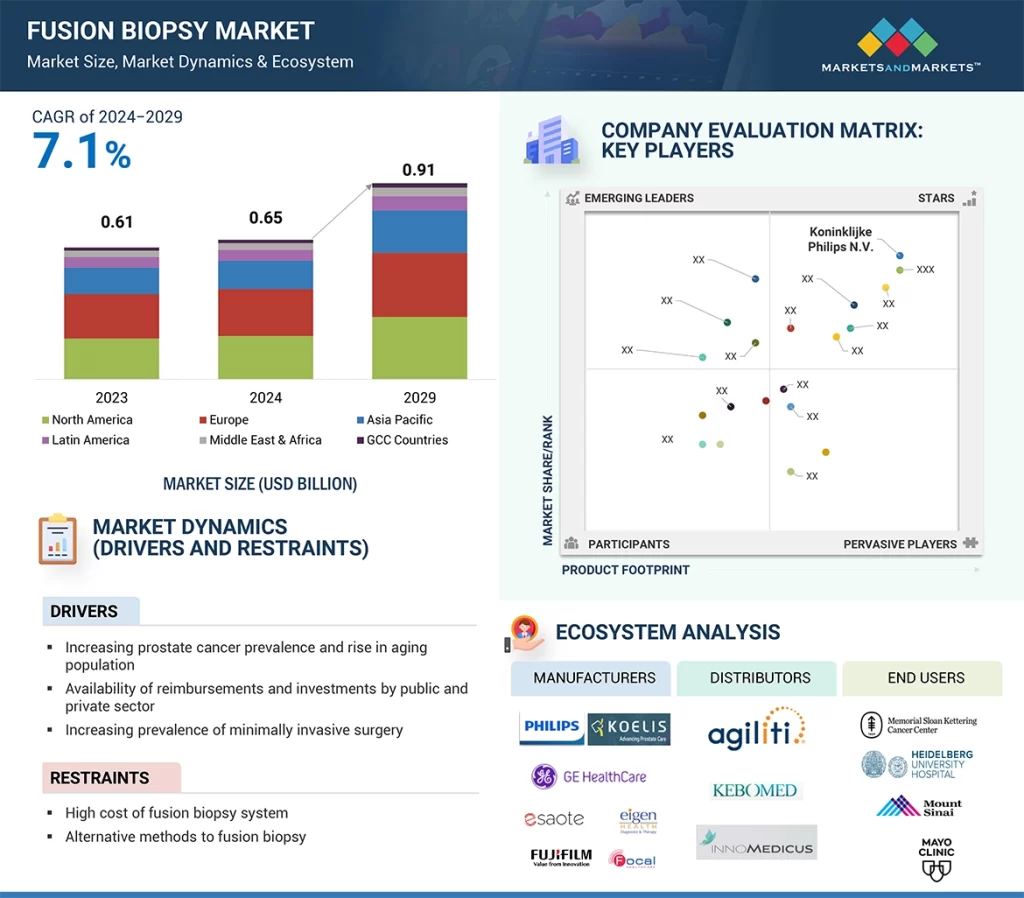The fusion biopsy market is experiencing significant growth, driven by technological advancements and the increasing prevalence of prostate cancer. Fusion biopsy, which combines MRI and ultrasound imaging, offers a minimally invasive and highly accurate method for detecting prostate malignancies. This article delves into the current trends, market drivers, and growth opportunities within the fusion biopsy sector.

Market Overview
As of 2024, the global fusion biopsy market is valued at approximately USD 0.65 billion and is projected to reach USD 0.91 billion by 2029, growing at a compound annual growth rate (CAGR) of 7.1%. This growth is primarily attributed to the rising incidence of prostate cancer and the aging global population. Fusion biopsy’s ability to provide precise targeting of suspicious lesions has made it a preferred diagnostic tool among healthcare professionals.
Key Market Players
The fusion biopsy landscape is dominated by several key players:
Koninklijke Philips N.V.: Known for its UroNav system, Philips has established a strong presence in the market by integrating advanced imaging technologies that enhance diagnostic accuracy.
GE HealthCare: With a focus on MRI and ultrasound innovations, GE HealthCare provides solutions that improve image quality and integration, facilitating more effective fusion biopsy procedures.
KOELIS: Specializing in prostate cancer diagnostics, KOELIS offers the Trinity system, which enhances accuracy in MRI-ultrasound fusion-guided biopsies.
Technological Advancements
Recent technological developments have significantly impacted the fusion biopsy market:
Integration of Artificial Intelligence (AI): AI algorithms are being incorporated to improve lesion detection and biopsy precision, leading to more accurate diagnoses.
Enhanced Imaging Modalities: Advancements in MRI and ultrasound technologies have resulted in clearer imaging, allowing for better visualization of prostate abnormalities.
Development of Portable Devices: The creation of compact and mobile fusion biopsy systems has increased accessibility, enabling procedures in a wider range of clinical settings.
Market Drivers
Several factors are propelling the growth of the fusion biopsy market:
Rising Prostate Cancer Rates: Prostate cancer remains one of the most common cancers among men, necessitating improved diagnostic methods.
Preference for Minimally Invasive Procedures: Patients and healthcare providers are increasingly opting for procedures that offer reduced recovery times and fewer complications.
Supportive Reimbursement Policies: In many regions, insurance coverage for fusion biopsy procedures has improved, making them more accessible to patients.
Regional Insights
The fusion biopsy market exhibits varying dynamics across different regions:
North America: Holding the largest market share, North America’s dominance is due to its advanced healthcare infrastructure and high awareness levels regarding prostate health.
Europe: With a significant elderly male population, Europe represents a substantial market, with countries like Germany and the UK leading in adoption rates.
Asia Pacific: This region is expected to witness the highest growth rate, driven by increasing healthcare investments and a growing prevalence of prostate cancer.
Challenges
Despite the positive outlook, the fusion biopsy market faces certain challenges:
High Equipment Costs: The sophisticated technology involved in fusion biopsy systems can be expensive, potentially limiting adoption in cost-sensitive regions.
Need for Specialized Training: Effective use of fusion biopsy equipment requires specialized training, which may not be readily available in all healthcare settings.
Growth Opportunities
The fusion biopsy market offers several avenues for growth:
Emerging Markets: Countries in the Asia Pacific and Latin America are investing in healthcare infrastructure, presenting opportunities for market expansion.
Technological Innovations: Ongoing research and development are likely to yield more advanced and cost-effective fusion biopsy solutions.
Collaborative Ventures: Partnerships between medical device companies and healthcare providers can facilitate the development of tailored solutions and broaden market reach.
Conclusion
The fusion biopsy market is poised for substantial growth, driven by technological advancements and an increasing demand for accurate, minimally invasive diagnostic procedures. Stakeholders in this industry should focus on innovation, strategic partnerships, and expanding into emerging markets to capitalize on the opportunities presented by this evolving landscape.
